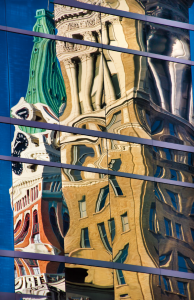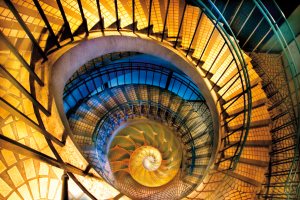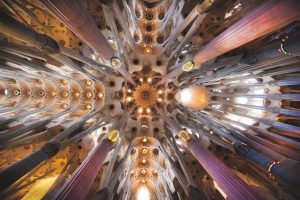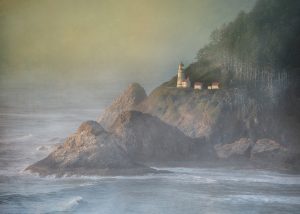The following is an excerpt from Harold Davis’s Composition & Photography
“You don’t make a photograph just with a camera. You bring to the act of photography all the pictures you have seen, the books you have read, the music you have heard, the people you have loved.” —Ansel Adams

Persistence of Reflection—Wandering in downtown Oakland, California, with my camera, I came across a modern office tower with curved reflective glass windows. The older buildings refracted and reflected in this curvature created a fascinating partial abstraction in this composition. I used a polarizer to help accentuate the reflections.
Nikon D300, 28-300mm Nikkor zoom at 170mm, circular
polarizer, 1/250 of a second at f/7.1 and ISO 500, hand held.
A composition, as in a photographic composition, is a noun. However, the act of creating a composition is denoted by a verb, to compose, or in participle form, composing. To compose is an active verb. It is not passive. Composing is something the photographer does, not something that is done to the photographer. It is very important to take an active part in becoming fluent with the language of composition, and with using the power of composition to enhance your creative work.
I began Composition & Photography with a quotation from Edward Weston that suggested that “to consult the rules of composition before making a picture is a little like consulting the law of gravitation before going for a walk.” This seems true to me. You don’t think when you breathe. At the same time, to become proficient at photography, one must master composition. So how is the novice to obtain and internalize the skills to be able to reflexively create compelling compositions?
This is not a process, or practice, that happens automatically. You must work at it, and for one thing, literally practice! The more photographs you make and the more attention you pay to composition, the more likely your photographs are to improve.
A practice, as a noun, is a way of doing something, the actual application of an idea or method, a process and procedure. As a verb, to practice means to perform or to exercise in order to improve one’s proficiency at something.
I chose practice as part of the title of this chapter because I believe that practicing composition is a lifelong endeavour. Composition involves practicing skills that will improve over time; it also means learning to see the world with a particular mindset related to design.
The second epigraph at the beginning of Composition & Photography is from Ansel Adams, a fount of pithy but accurate quips about all aspects of photography. Adams stated that “there are no rules for good photographs, there are only good photographs.”
In other words, we know good photography when we see it, but there are really no objective rules concerning its creation. This presents an additional difficulty for the photographer who wishes to internalize “good” composition there are no rules to internalize.
I believe that the answers to these twinned dilemmas lie along two tracks.

Spirals—My idea in creating this image was to combine two quintessential spirals in a post-production collage. The spiral staircase, photographed in San Francisco’s Embarcadero Center, represents a common architectural embellishment. The spirals in a nautilus shell are nature’s way of creating architectural housing for a cephalopod.
Visually, you enter this image at the top and wander down the staircase. Before you know it, the constructs of humanity have changed to that of nature, and you are within the spirals of the nautilus. Working in Photoshop, once I had conceived of this idea, the primary technical challenge was to make sure the transition between staircase and shell was visually seamless.
Digital combination of two images, Spiral Staircase and Nautilus Shell.
Spiral Staircase: Nikon D200, 18-200 Nikkor zoom at 18mm, 6 seconds at f/22 and ISO 100, tripod mounted.
Nautilus Shell: Nikon D200, 50mm macro, 8 seconds at f/32 and ISO 100, tripod mounted, combined with a flatbed scan of the center of the shell.
Key Ideas in Composition
The first and broadest track in the practice of composition involves living a full life as a human being. As part of this, one should develop as complete a set of ideas and tools as a person, artist, and photographer (in this order) as possible. One also needs to understand oneself as well as one can
More narrowly, the study of composition itself is important. I believe that composition is correctly categorized in the context of two-dimensional art generally. This implies that it is important not to limit compositional studies to photography, and to keep an eye on the broader range of visual art. It is my premise in Composition & Photography that the most fruitful study of composition involves placing imagery in the context of design. Since, as Adams put it, there are no rules, how should this study of composition proceed?
Two-dimensional art, such as photography, is usually formally bounded by a frame. The photographer can design within that frame starting with lines, circles, and rectangles.
It’s absolutely amazing how expressive a simple line can be, and how complex images can be created using only lines.
Circles are a universal shape that are related to wholeness, our relationship to the universe, and our position on Mother Earth. The circle is a valuable shape to become familiar with because it means so much.
The frame is a rectangle, but in the context of a photograph also contains and bounds the image. While the concept of framing—not a picture frame!—often confuses people, once you’ve become clear about framing, the power of your compositions will be significantly enhanced.
A composition can get more complex and interesting when you add patterns and repetition and spirals and fractals. To take one of these important shapes, the fractal is astounding because a simple shape slightly varied and repeated can lead to almost infinite variations.

Sagrada Familia—Sagrada Familia, formally the Basilica de la Sagrada Familia, is an unfinished Roman Catholic church that is about 135 years old, located in Barcelona, Catalonia. It is a UNESCO World Heritage Site, and the masterpiece of Catalan architect Antoni Gaudi.
Gaudi’s work was largely influenced by nature, although he was also known for his introduction of new techniques and materials in construction, particularly his use of ceramics. The Sagrada Familia echoes important Gothic and Asian structures while incorporating natural motifs in every aspect of its design. For example, the columns holding up the cathedral roof are carved to be reminiscent of trees, and their shape is definitely fractal-like.
For me, the experience of visiting the Sagrada Fam lia is more like being in a very special organic and natural shape than like visiting a conventional cathedral. Perhaps it is this conflation of nature with the ineffable that makes the Sagrada Familia such a special and other-worldly space.
When I made this photo inside the Sagrada Familia, I used an extreme wideangle lens (15mm) to help capture the organic and forest-like nature of the cathedral ceiling. Since I could not use a tripod, I raised my ISO to 1000 so that I could get decently sharp results even while hand holding.
Nikon D810, 15mm Zeiss Distagon, 1/100 of a second at f/2.8 and ISO 1000, hand held.
An appreciation for patterns, spirals, and fractals is greatly enriching and can yield a harvest of subtle and complex imagery.
Once placed within a frame, a photographic composition has visual entry points and exit points. The way a viewer visually approaches a photograph is a completely different system of formal design, but it can be manipulated, and this is extremely powerful once you grasp how it works.
If there is a depiction of “reality” in a photograph, vanishing points and perspective must be considered. Since single-point perspective is expected in a photograph, why not take this expectation and turn it on its head? Symmetry and asymmetry and positive and negative space are visual motifs that spice compositional interest up a notch. And, contrary to many expectations, photographs, like any other art form, are often partially or completely abstract.
I hope you’ve enjoyed the journey and process of composition in my book. Hopefully these tools will help you analyze photographs and compositions. Most important, I hope you find the ideas in Composition & Photography useful in your own creative work.

Heceta Head Lighthouse—Along the rocky and storm-bound coast of Oregon, Cape Perpetua rises almost 1,000 feet above the Pacific Ocean. Isolated, with connection to the world only by water or dangerous trail until the 1930s, the Hecata Head Lighthouse was built to safeguard shipping in this perilous region.
As the golden light of late afternoon faded into evening, from across Cape Cove near Devil’s Elbow, I photographed the Heceta Head Lighthouse with a telephoto lens (230mm). I bracketed my exposures from 1/500 of a second, which captured the waves, to 1/30 of a second, which allowed me to render some of the details in the comparatively dark forest.
In post-production, I worked on combining the different layers that made up this image to add a painterly effect so that my image would show the overall romantic nature of this scene.
Nikon D850, 28-300 Nikkor zoom at 230mm, five exposures with shutter speeds ranging
from 1/500 to 1/30 of a second at f/8 and ISO 200, tripod mounted.
